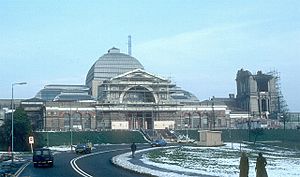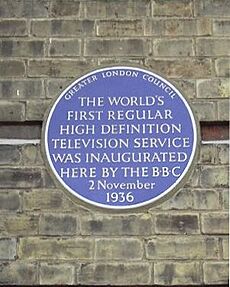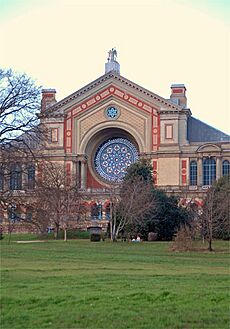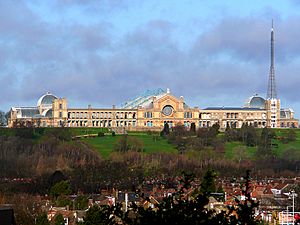Alexandra Palace facts for kids
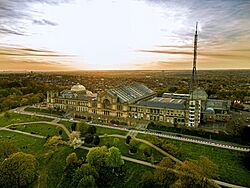
Alexandra Palace at sunset in April 2021
|
|
| Location | Alexandra Park, London, N22 |
|---|---|
| Coordinates | 51°35′39″N 00°07′51″W / 51.59417°N 0.13083°W |
| Public transit | |
| Operator | Alexandra Park and Palace Charitable Trust |
| Capacity | 800 (Panorama Room) 1,750 (East Hall/Ice Rink) 2,000 (Palm Court) 2,500 (West Hall) 10,250 (Great Hall) 900 (seated)/1,300 (seated/standing) (Theatre) |
| Construction | |
| Broke ground | September 1865 |
| Opened | 1 May 1875 |
| Renovated | 1873–75, 1980–88, 2016–17 |
| Construction cost | £417,000 (£29.2 million in 2021 pounds ) |
| Architect | Owen Jones, John Johnson and Alfred Meeson |
| Builder | Kelk and Lucas |
|
Building details
|
|
| General information | |
| Inaugurated | 24 May 1873 |
Alexandra Palace is a famous entertainment and sports venue in North London. It sits between Wood Green and Muswell Hill. This amazing building is a Grade II listed site, meaning it's very important and protected.
It was first built by John Johnson and Alfred Meeson. It opened in 1873. Sadly, a big fire destroyed it just two weeks later! But it was quickly rebuilt by Johnson. People called it "The People's Palace" or "Ally Pally". It was meant to be a fun place for everyone. It was North London's answer to the Crystal Palace in South London.
At first, it was owned by a private company. In 1900, they wanted to sell it for building new homes. But a group of local councils stepped in. They bought the Palace and Alexandra Park. An Act of Parliament (a special law) created the Alexandra Palace and Park Trust. This law said the trustees must keep the building and park open for everyone to use, forever. Today, the London Borough of Haringey council is the trustee. Their coat of arms even shows lightning bolts. This is a nod to Alexandra Palace's big role in early television!
In 1935, the BBC rented part of the Palace. They used it to create their new television service. In 1936, it became the home of the BBC's first regular TV broadcasts. This was the world's first fully electronic TV system! Even though other TV studios opened later, the BBC used Ally Pally for many years. Its radio and television mast is still used today.
The original TV studios are still there. You can find them in the southeast part of the building. They are now used to show old TV equipment. The old Victorian theatre is also still standing. It has special stage machinery. As of 2019, the theatre is being used again. Alexandra Palace became a listed building in 1996.
The Great Hall and West Hall are often used for big events. These include exhibitions, music concerts, and conferences. The Palace also has a pub, an ice rink, a beautiful palm court, and amazing views of central London.
In 2013, Alexandra Park became a local nature reserve. It's also an important place for nature conservation. You can get to Alexandra Palace by train or tube. The nearest stations are Alexandra Palace and Wood Green.
Contents
A Look Back: The History of Ally Pally
How It All Began: The 1800s
The idea for "The Palace of the People" came about in 1859. A company was formed to build it. They even reused building materials from the big 1862 International Exhibition in South Kensington. In 1863, the Alexandra Park Co. Ltd. bought land on a high ridge. This land became the park and the site for the Palace. Alexandra Park opened to the public on 23 July 1863.
The planned building was first called "The Palace of the People." But it was renamed to honor the popular new Princess of Wales, Alexandra of Denmark. She married Prince Albert Edward in 1863. Construction started in September 1865. The design was by John Johnson and Alfred Meeson.
Work on a railway line to the site also began in 1871. Both the railway and the Palace were finished in 1873. Alexandra Palace and Park officially opened on 24 May 1873. The building covers about 7.5 acres. Just 16 days later, a huge fire destroyed the Palace. Three staff members also died. Only the outer walls remained.
The Palace was rebuilt very quickly. It reopened on 1 May 1875. The new Alexandra Palace had a concert hall and art galleries. It also featured a museum, lecture hall, and a large theatre. The theatre stage had special machines for cool effects. Performers could disappear or fly into the air! An outdoor swimming pool was also built in the park.
The grounds also included a horse racing course. It was London's only racecourse for many years. There was also a Japanese village and a boating lake. A Henry Willis organ was installed in 1875. It was damaged but later restored. In 1929, it was called the best concert organ in Europe!
The 20th Century: TV and More Fires
| Alexandra Park and Palace (Public Purposes) Act 1900 | |
|---|---|
| Act of Parliament | |

|
|
| Long title | An Act to constitute a body of Trustees for the purpose of acquiring the Alexandra Park Palace and other lands in the county of Middlesex and to empower them to hold and manage the same as a place of public resort and recreation and for other public purposes and to make all provisions necessary or proper in that behalf. |
| Citation | 63 & 64 Vict. c. cclix |
| Dates | |
| Royal assent | 6 August 1900 |
In 1900, the owners wanted to sell Alexandra Palace and Park for new buildings. But a group of local people, led by Mr. Henry Burt, bought them. They wanted to save the Palace and grounds for everyone in London. A special law was passed, the Alexandra Park and Palace (Public Purposes) Act 1900. This law created a trust. The trust's job was to keep the Palace and park open for the public forever.
During the First World War, the park was closed. The Palace was first used as a camp for Belgian refugees. Then, from 1915 to 1919, it was a camp for German and Austrian civilians.
In 1935, the BBC leased part of the Palace. They made it their center for a new BBC Television service. The world's first public broadcasts of "high-definition" television happened here in November 1936. Two different TV systems were tested. The 405-line system was chosen in 1937. After the BBC moved in, the theatre was used for storing props.
The Palace was the BBC's main London TV center until 1956. During World War II, the transmitter helped by jamming German bombers' navigation systems. In 1944, a German doodlebug exploded near the Great Hall. The beautiful Rose Window was shattered. The Palace also had a public roller-skating rink in the 1940s and 50s.
The BBC continued to use the Palace for news until 1969. It was also used for the Open University until 1981. The antenna mast is still there today. It is used for local TV and radio broadcasts.
In 1980, another fire started under the organ. It quickly spread and destroyed half the building. Luckily, the outer walls survived. The theatre and BBC Television studios were also saved. Parts of the famous organ were lost. The council spent a lot of money to fix the damage. The Palace reopened in 1988.
An ice rink was added to Alexandra Palace in 1990. It's used for public skating and by ice hockey teams. It's also home to a figure skating club.
The 21st Century: New Life for Old Spaces
In 2004, performances returned to the theatre after about 70 years. It was clear how much potential this huge space had. Plans to fully reopen the theatre were made. However, a lot of expensive repairs were needed first.
In 2007, plans to turn the building into a big commercial complex were stopped. This included ideas for a casino and a hotel. Many people opposed these plans. The High Court decided against them.
In 2012, a new plan was made for the future of the site. One big idea was to fix up the old eastern end of the Palace. This would make the Victorian theatre and BBC Studios open to the public. In 2013, they received funding to start this project. The goal was to create a new entrance and reopen the theatre and BBC Studios.
In 2018, the long-abandoned Alexandra Palace theatre and east wing were refurbished. The theatre officially reopened to the public on 1 December 2018. The opening included performances from famous artists and shows.
During the coronavirus pandemic, Alexandra Palace helped the community. It was used as a food distribution center for local residents.
Exciting Events at Ally Pally
Alexandra Palace has hosted many amazing events over the years.
Regular Fun
- The PDC World Darts Championship has been held here since 2008.
- The Masters snooker tournament has been played here since 2012.
- Every November, there's a huge fireworks display for Bonfire Night.
Past Highlights
- In 1967, a famous music event called "The 14 Hour Technicolor Dream" took place. Bands like Pink Floyd performed. John Lennon attended, and Yoko Ono performed her "Cut Piece."
- In 1972, the rock band Led Zeppelin played two sold-out shows.
- The American band Grateful Dead played three shows here in 1974.
- In 1980, a fire started during a Jazz Festival. It destroyed parts of the Great Hall and Ice Rink.
- The burnt-out hall was used as "Victory Square" in the 1984 film 1984.
- In 1985, the Sinclair C5 electric car was launched here.
- Blur performed a big concert in 1994 to promote their album Parklife.
- From 1993 to 1995, the Brit Awards were held at Alexandra Palace.
- In 1996, it hosted the 1996 MTV Europe Music Awards.
- In 2000, the fourth Mind Sports Olympiad took place. Over 4,000 people competed in mind games.
- In 2007, a lightning strike during an event caused it to rain inside the building!
- In 2011, Björk performed one of her last "Biophilia tour" concerts here.
- During the 2012 Summer Olympics, it was the official place for the Dutch Olympic team.
- Many famous musicians have played here, including Florence and the Machine, Slipknot, and Twenty One Pilots.
- In 2016, the bootcamp stage for The X Factor was filmed at the Palace.
- In 2020, Nick Cave recorded his live album Idiot Prayer in the West Hall.
- In 2021, London Grammar performed their album Californian Soil live.
- The Duke and Duchess of Cambridge presented the Earthshot Prizes here in 2021.
- Fontaines D.C. played their last UK tour show here in 2021.
- In 2021, Bethesda Softworks held a concert to celebrate the 10th anniversary of The Elder Scrolls V: Skyrim.
See also
 In Spanish: Alexandra Palace para niños
In Spanish: Alexandra Palace para niños








